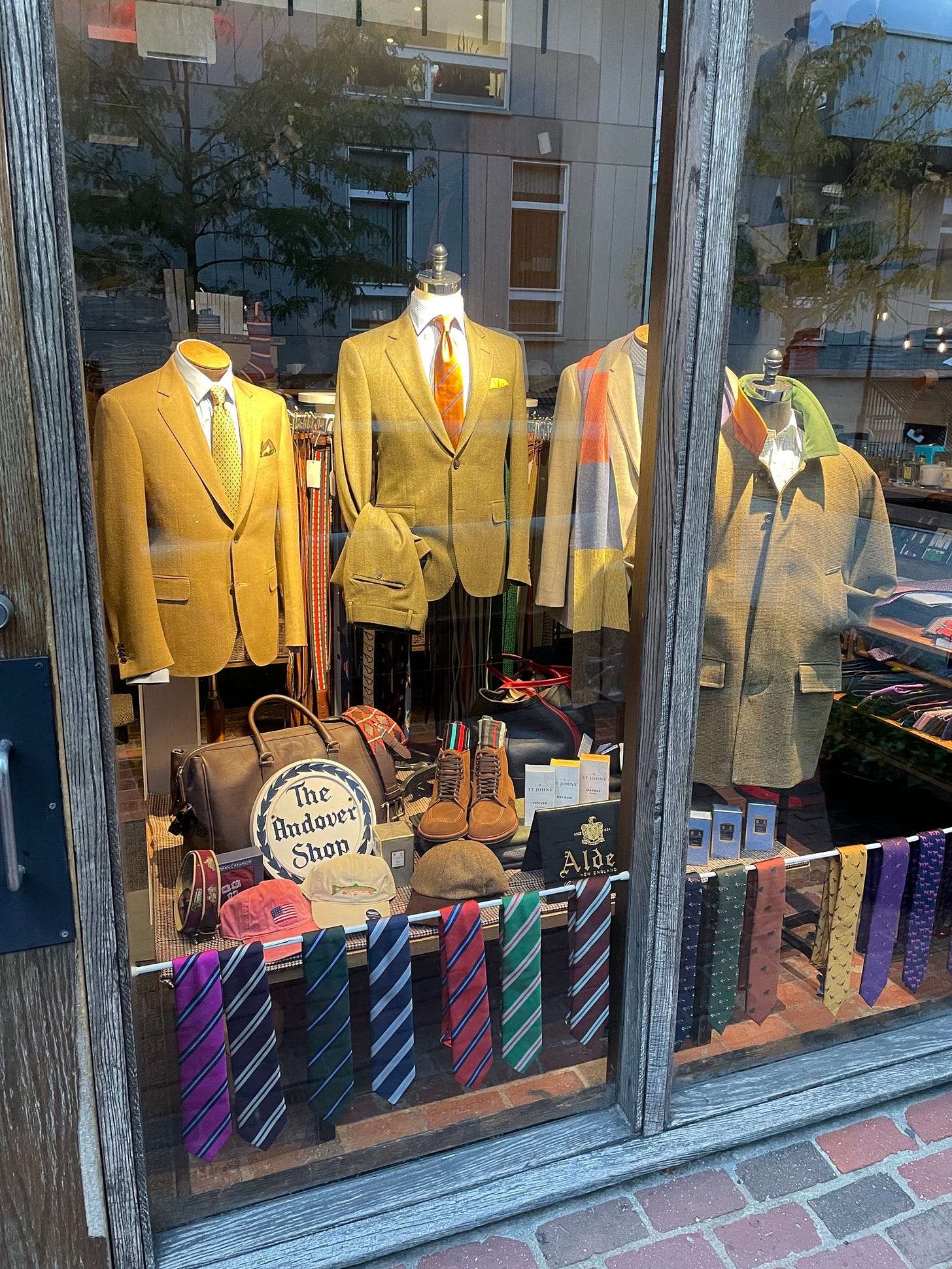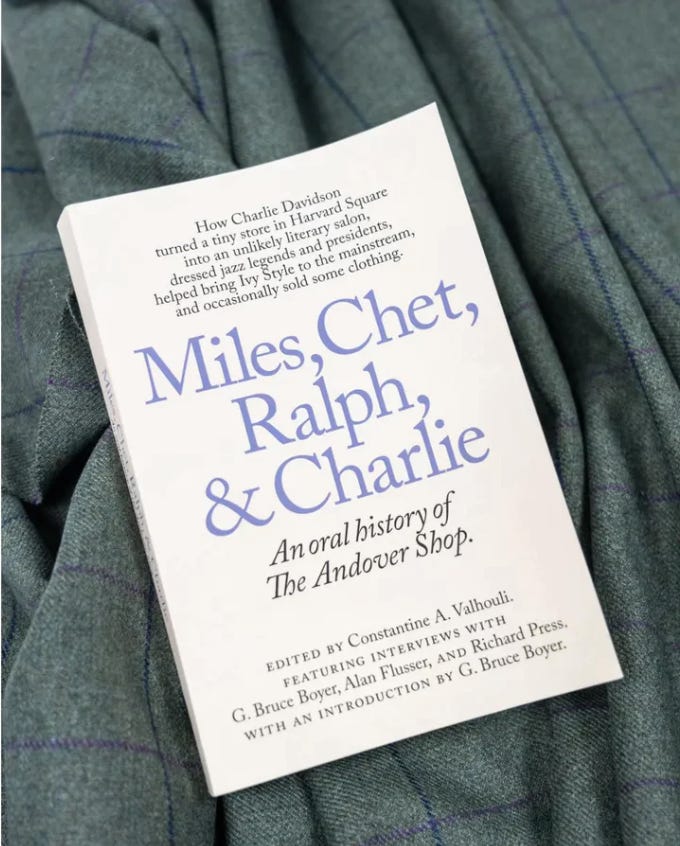"When Jazz Musicians Were Heroes, and Men Dressed With an Easy Elegance."
The Andover Shop gets the oral history it deserves.
If you’ve met me in person, I’ve probably at some point referenced working at The Andover Shop. Even though my employment there spanned a relatively short interlude in my life—as a part-time employee from the fall of 2021 to the spring of 2022, and then as an abstract “there when needed” role I likened to substitute teaching for about another year (though to this day, I’m sometimes ordered to bring boxes down to the basement when I show up as a “civilian”).
And to be clear, what I was doing was folding shirts, rummaging for club ties in the basement, and searching (often fruitlessly) for customers’ order forms in their decades-old filing system, which remains entirely analog. I have the upmost respect for those retail-lifers who do the actual measuring, chalking and pinning, which is why I’d never claim to be of their ilk.
But all the same, I loved it, and I loved being there. There was the joy of being around beautiful clothing every day—which if I wasn’t careful, led to myself buying the merchandise on a slow day—but there was always the sense that what the Andover Shop was about was much more than clothes. Even in my brief tenure, which came after the passing of its legendary owner Charlie Davidson in 2019, there was still a strong sense of the shop functioning as an informal community hub, a place where everyone from Harvard faculty to visiting musicians to the owner of the local pizzeria would come in and just talk for hours, sometimes buying clothes in the process.
As such, it served as a repository of stories—about Cambridge, about Harvard Square, about Charlie Davidson—that I’d hear told and retold multiple times in my short run. The sort of stories you’d hoped might be preserved once the tenuous bonds that still connect them to the present are cut.
So I was delighted to learn that my friend Constantine Valhouli had begun writing an oral history of the shop in 2021. Two years later, this project—for which Valhouli conducted original interviews with living menswear legends like Alan Flusser, Richard Press and G. Bruce Boyer as well as a small constellation of customers, tailors, former employees and friends—has been published as “Miles, Chet, Ralph, and Charlie: An Oral History of The Andover Shop.”
Something that was often said about Charlie—and is touched on more than once in the book—is that he paradoxically never liked to talk about clothes. It’s fitting, because although tweeds and MTM-tailoring are obviously remarked upon in the book, they serve as a sort of MacGuffin, merely connecting the other threads linked to the shop’s 75-year-history: jazz music, literature, American race relations, community and belonging.
It also paints a vivid picture of another Boston, and in many ways, another America that I and most readers will have never known. Without ever coming across as curmudgeonly or reactionary, its interviews suggest a time when people put a little more thought into their appearance, the merits of new American music warranted serious discussion and everyday life seemed just a touch more elegant.
Or as Bruce Boyer, who in a line I’ve come back to again and again, and even pilfered from for the tagline of this newsletter, says in its pages: “When jazz musicians were heroes, and men dressed with an easy elegance. A time when substance had style.”
Cut, Make and Trim
I’ve written about working at The Andover Shop before, in a short piece for Ivy-Style.com published last summer. I’ve also written a piece for the shop, which just commemorated its 75th anniversary, for WM Brown’s upcoming fall issue.
This week at Robb Report I wrote a first-person review of Nakata Hanger’s Giorno Valet Stand, broke the news of Angel Ramos opening his first RTW location in Manhattan, and filed the ol’ Best New Menswear round up.
Bringing these circles together, I was delighted and surprised to see Robb Report’s editor Paul Croughton give a strong recommendation for “Miles, Chet, Ralph, and Charlie” on his Instagram page last week.
I like Angel’s style a lot. He’s the sort of guy I wouldn’t dream of copying outright—I don’t have the cigar-chomping swagger required to pair a zebra-print overcoat with smoking slippers—but the general cut of his clothes, slightly loose and high-waisted and all-around drapey, is a great look.
I may write more on this in a later newsletter, but Buck Mason just released a “West Coast Ivy” collection, and it is TSC-approved.
Much like the Japanese soldiers who continued to holdout on remote islands for decades after WWII ended, I have continued to soak my jeans in the bathtub with a touch of detergent and white vinegar like the last man standing from 2009. So I was relieved when I wrote about denim care for InsideHook a few weeks back, and two of the smartest guys in the biz—Victor Lytvinenko of Raleigh Denim Workshop and Jeremy Smith of Standard & Strange—both told me to just throw them in the washing machine and air-dry after.
Following this advice, a I finally machine-washed my RRL Vintage 5-Pockets, merely turning them inside-out as the only pre-caution. And guess what: they faded just a touch more than they would have in the tub, losing a pleasing amount of indigo along the edge of the pockets and the rise that have proved deeply satisfying to look at.
You may have noticed that this newsletter now has super-spiffy branding and a nice little avatar of its own. I owes this entirely to the talent of my brother Ryan, who when he’s not working for free on my behalf is busy designing furniture.






